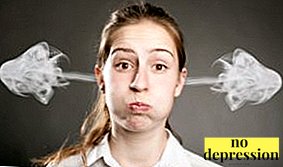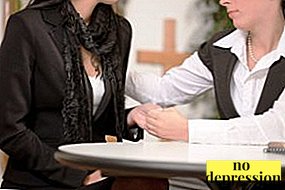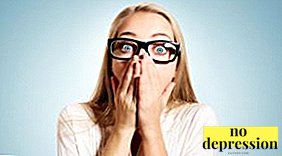According to statistics, from 0.5 to 2% of people on the planet suffer from recurrent depressive disorder.
Most often, this pathology occurs in patients with a history of other mental illnesses, but it can also occur as an independent pathology.
What it is?

The term "recurrent" means "Repeated", "periodic".
By recurrent depressive disorder is meant periodic recurrence of depressive episodes with varying degrees of severity.
At the same time, the patient does not have episodes of hyperactivity and heightened mood, characteristic of manic disorders.
This pathology is quite common. Usually people over 40 years old suffer from it, while manic-depressive psychosis manifests at an earlier age. According to ICD 10, the disease has a number F33.
The disorder occurs in each patient individually. However, despite the large number of features, it is based on the same scenario of attacks.
Last bouts of depression can last from one to several months, then remission is comingduring which the patient is no different from healthy people.
With age, the duration of the period of exacerbation increases. Usually manifestations of pathology have seasonal nature, an attack can also be triggered by an external irritant (stress, illness, overwork).
According to medical records, women suffer from recurrent depression twice as often as men. Perhaps this is due to the fact that depressive manifestations in women expressed much brighter.
 While the male symptoms are not associated with mental disorders, they are explained by fatigue or age.
While the male symptoms are not associated with mental disorders, they are explained by fatigue or age.
If the attacks of exacerbations of DDR are repeated infrequently, the patient there are no problems with social adaptation. However, mortality from this disease is comparable to mortality from heart disease.
About 15% of patients end suicide. Recently, doctors have noted a trend towards weighting the flow of DDR.
In patients relapses become more frequent, the duration of attacks increases, the appearance of complications increases. According to WHO, DDR ranks second among all causes of disability and death patients at a young age.
Causes of pathology
To date, the exact causes of the occurrence of recurrent depression has not been established. According to psychiatrists, RDR occurs due to the impact of a whole complex of factors: social, organic and psychological.
Causes of DDR are divided into:
- endogenous (genetic predisposition);
- psychogenic. Typically, depression is a reaction to psychological trauma, stress;
- organic. These include head injuries, neuroinfections, poisoning, brain tumors, which provoke organic changes in the brain.

Usually the first attack occurs under the influence of external factors: stress, nervous tension.
Repeat episodes already are independent manifestations that are not associated with external influence.
Psychiatrists secrete the monoamine theory of depression, which explains the onset of DDR by congenital insufficient hormone activity: serotonin, adrenaline.
In other words, so that the patient develops a recurrent depressive disorder, At least one of the following factors must be present:
- The presence of mental illness in close relatives.
- A stressful situation: death of a loved one, stress at work, conflicts in the family, serious illness.
- Brain lesions (infections, injuries, tumors).
- Alcohol and drug use.
Recurrent depressive disorder - a history of the disease.
Classification
By severity DDR course is divided into: mild, moderate and severe recurrent depressive disorder.
According to the type of provoking factor, the following DDR groups are distinguished:
- Endogenous recurrent depression. Pathology is caused by abnormalities inside the body. In this case, the synthesis of certain hormones (serotonin, norepinephrine) decreases in the body. This may be due to endocrine disease.
 Reactive (psychogenic) depression.
Reactive (psychogenic) depression.
The perpetrators are external influences that trigger severe stress: divorce, death of a relative, loss of work.
Symptoms
The first signs of DDR usually appear at the age of 40 years. The episode of depression lasts about 6 months, it is replaced by a period of remission, which lasts from 2 months.
In between the attacks of symptoms of depression are absent. Although in old age there is a high risk of chronicity of the process.
Main symptoms diseases:
- the patient has increased fatigue, reduced energy potential;
- a person does not get pleasure from what he was fond of before, loses interest in everything;
- the patient is constantly in a depressed mood.
When the duration of the symptoms is more than 14 days, this is DDR. In addition, the patient observed related signs:
- reduced self-esteem, the appearance of self-doubt;
- unreasonable feeling of own guilt in everything that happens;
- thoughts and suicide attempts;
- pessimistic view of the future;
- distracted attention;
- loss of appetite or bulimia;
- poor sleep, nightmares, daytime sleepiness.

Recurrent depression occurs in childhood.
Such children are withdrawn, uncommunicative, irritable. They often have suicidal thoughts.
In men, DDR is accompanied by uncontrolled outbreaks of aggression. Somatic manifestations are characteristic of women: headache, abdominal pain, muscle spasms, dizziness.
Number of symptoms present depends on the severity of the disease:
- In case of a mild patient, 2 main and 2 additional features are recorded.
- With moderate severity, there are two main and 4 concomitant.
- In severe cases, the patient has all the main and 4 additional signs.
Patients with severe disorders recur bouts of delirium and hallucinations. Patients hear voices accusing them of "all mortal sins."
Olfactory hallucinations are manifested by the smell of rotten meat. Also, the patient may experience depressive stupor.
For DDR is characterized by the absence of manic episodes. If at least one manifestation of mania was recorded, then we are talking about bipolar affective disorder.
Diagnostics

When making a diagnosis, it is necessary to differentiate recurrent depression from schizophrenia and organic affective disorder.
Diagnosis is carried out by a psychiatrist. The leading role belongs to the clinical interview with the patient and his relatives.
The doctor asks the patient about:
- Episodes of depression in the past.
- The presence of mental pathologies in relatives.
- Injuries, neuroinfections, poisoning, preceding the appearance of an attack.
- Psychological situation in the family, at work.
- Available chronic diseases and used drugs.
- The emergence of suicidal thoughts and suicide episodes in close relatives.
Consultation and examination of a neurologist are scheduled. on the subject of:
- Disorders of the central nervous system.
- Weakening reflexes.
- Desensitization.
- Violations of movement coordination.
- Impaired speech, memory, consciousness.
Then prescribe laboratory and instrumental studies:
- general and biochemical analysis of blood and urine. Investigate the level of cholesterol, prothrombin index;
- blood test for hepatitis, HIV, syphilis;
- electroencephalography;
- vascular doppler sonography;
- MRI of the brain.

With the help of these studies reveal the effects of injuries, brain tumors, atherosclerotic vascular lesions.
The patient will also need a consultation. ophthalmologist, endocrinologist, cardiologist.
All these doctors must interact with each other to determine the tactics of treatment of DDR.
Treatment
In severe disease, especially with the presence of suicidal thoughts and hallucinations, the patient hospital treatment is indicated.
The basis of the treatment of DDR is the appointment of antidepressants in small doses. If there are no side effects, the dosage of drugs is gradually increased until the symptoms disappear.
Currently using second and third generation products that have a minimum of side effects: Mirtazapine, Bupropion, Venlafaxine.
In severe cases, apply Tricyclic antidepressants: Amitriptyline, Clomipramine. Positive dynamics is fixed after 2-3 weeks. To consolidate the effect, the course continues for 6-8 weeks.
If a patient has persistent resistance to antidepressants and does not improve, additional electroconvulsive therapy. In extreme cases, indirect stimulation of the vagus nerve is performed.

A generator is implanted under the skin, which sends impulses to the brain through electrodes.
Disadvantages of the procedure are expensive and difficult to determine the intensity of stimulation.
At any stage of therapy, various psychotherapeutic effects are applied. These can be individual conversations with a psychologist, group trainings.
Basic techniques: cognitive-behavioral and interpersonal therapy. They are recognized as the most effective ways to treat mild and moderate DDR.
Prevention
After stopping the attack, the main task of the doctor is anchoring the effect, preventing relapse. For this assigned supportive drug therapy and sessions with a psychologist.
It has been proven that the risk of a recurrence of a seizure in patients who refuse drugs is as high as 50%, while drug treatment reduces it to 9%.
The course of maintenance therapy lasts up to 6 months. Equally important is support of relatives.
General conditions relapse prevention:
- Compliance with the recommendations of the doctor on medications.
- Creating a comfortable psychological situation in the family.
- Restore communication in society.
 Clear awareness of patients of the risk of re-attack in the use of alcohol and drugs.
Clear awareness of patients of the risk of re-attack in the use of alcohol and drugs.- Regular blood tests and prophylactic consultations with a psychiatrist.
Treatment of recurrent depressive disorder is long and complicated process.
Unfortunately, there remains a high risk of recurrence of seizures. Alone, the patient is not able to cope with his problem, so for him crucial support for loved ones.
Recurrent depressive disorder. Approaches to therapy:

 Reactive (psychogenic) depression.
Reactive (psychogenic) depression. Clear awareness of patients of the risk of re-attack in the use of alcohol and drugs.
Clear awareness of patients of the risk of re-attack in the use of alcohol and drugs.

